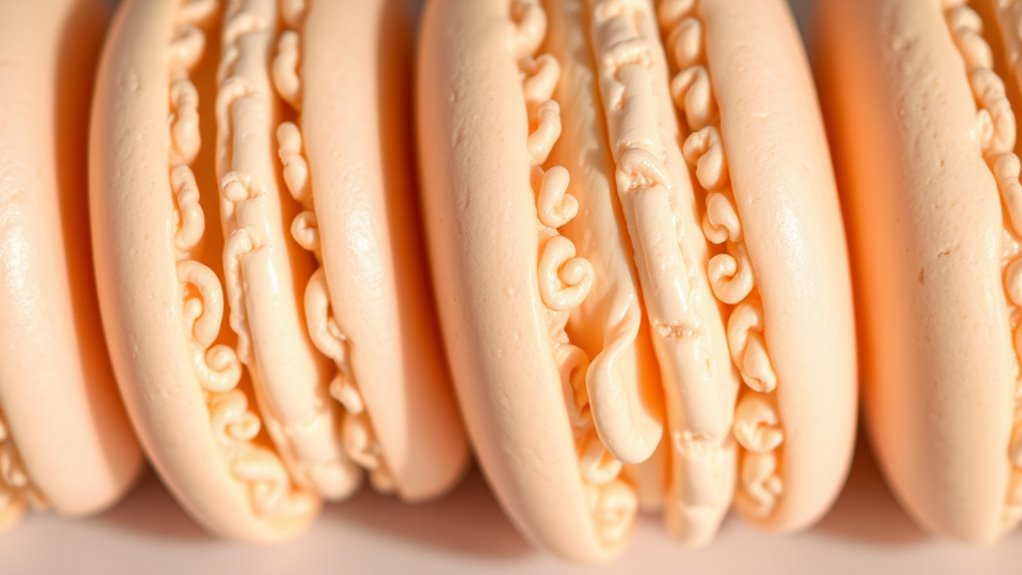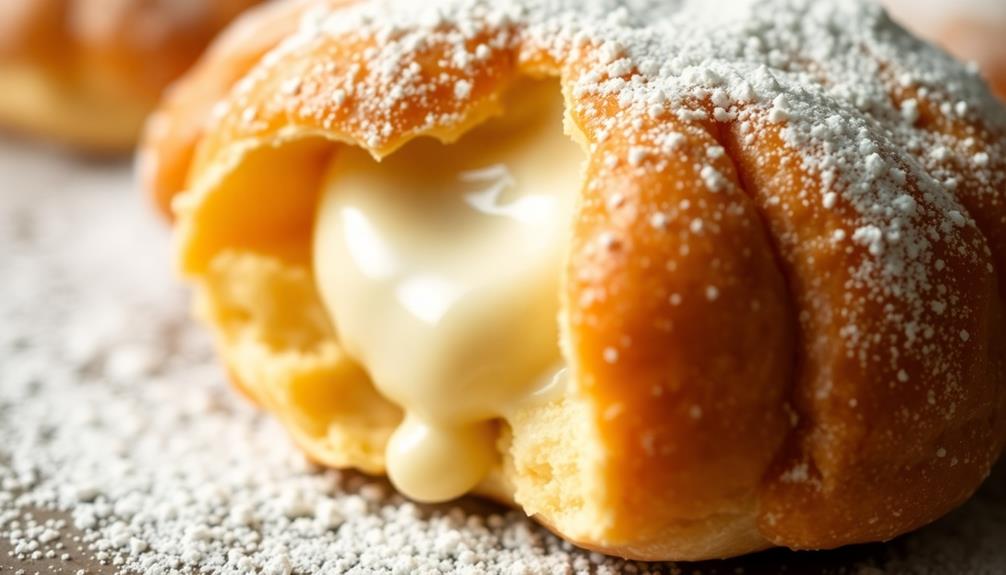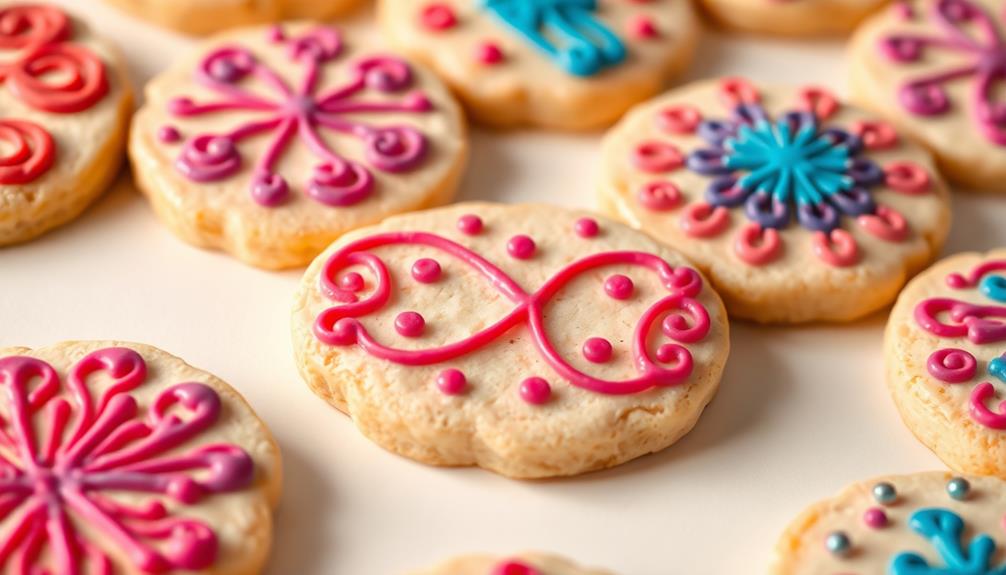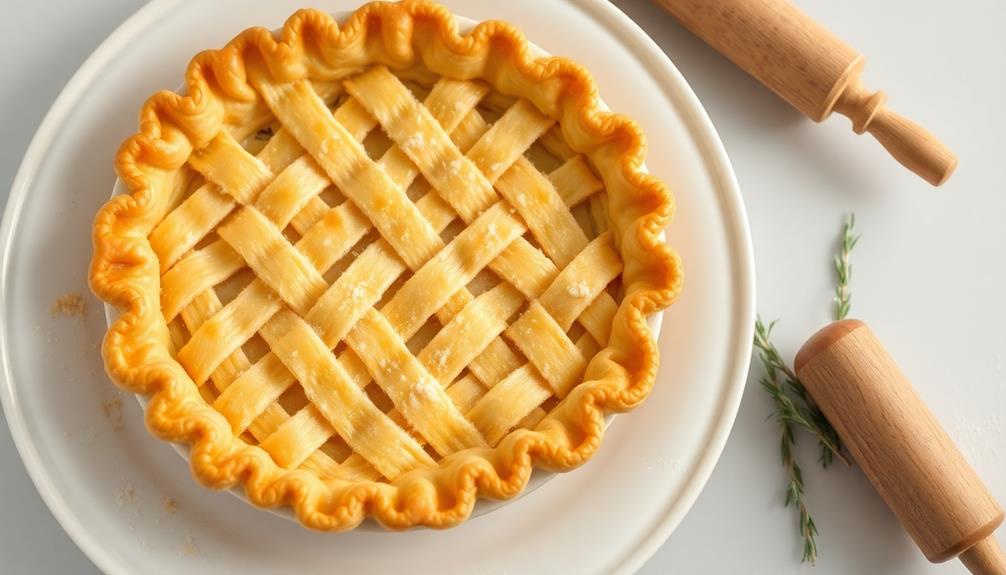To perfect French macaron feet, you need to control humidity, temperature, and meringue stability. Humidity affects how the shells dry and form a crust, so aim for a dry environment or use dehumidifiers. Confirm your meringue is thick and glossy for a stable batter, and dry piped shells until a skin forms. Managing these factors helps develop the classic ruffled foot. Keep exploring these techniques to achieve consistently flawless macarons.
Key Takeaways
- Maintaining optimal humidity levels prevents batter surface from drying or crusting prematurely, ensuring proper foot development.
- Achieving stiff, glossy meringue peaks is essential for stable batter and well-formed macaron feet.
- Allowing piped macarons to dry until a skin forms promotes ruffled, textured foot during baking.
- Controlling ambient temperature and humidity with dehumidifiers or fans enhances consistent foot formation.
- Proper environmental management combined with technique ensures smooth batter, adequate drying, and perfect macaron feet.

Have you ever wondered what gives a perfect French macaron its signature foot? That ruffled, textured edge at the base of each cookie is no accident. It’s the result of precise technique, especially during the macaron foot formation stage. Achieving that delicate foot depends heavily on factors like meringue stability, batter consistency, and, importantly, humidity impact. When you’re making macarons, understanding how humidity influences the process can make all the difference between a smooth, glossy shell with a perfect foot and a cracked or hollow one.
Humidity impacts the formation of the macaron foot because moisture in the air interacts with the meringue and the drying process. If the environment is too humid, the surface of the batter won’t dry out properly before baking, which can prevent the foot from developing fully. Instead of a ruffled, textured edge, you might end up with a flat or cracked shell. Conversely, very dry air can cause the batter to form a crust too quickly, trapping moisture inside and impairing the proper rise of the foot. This is why many bakers prefer to work in controlled environments or use dehumidifiers during the process. Additionally, controlling ambient temperature alongside humidity can further improve consistency.
Humidity influences macaron foot formation by affecting drying and moisture levels, leading to flat, cracked, or properly ruffled shells.
Getting the macaron foot formation right requires more than just environmental control; it begins with your meringue. You want your egg whites to reach stiff, glossy peaks, which will give your batter the right structure to rise properly. When folding the dry ingredients into the whipped meringue, be gentle but thorough, maintaining as much air as possible. A well-incorporated batter should flow smoothly off the spatula in a thick, lava-like consistency, indicating it’s ready to pipe. When piped onto the baking sheet, the batter should spread out slightly but hold its shape, forming a smooth top with a slightly ruffled edge starting to develop.
The drying process before baking is vital for foot formation. Allow the piped macarons to sit at room temperature until a skin forms—this usually takes 20 to 40 minutes, depending on humidity. If you skip this step or rush it, the foot may not develop fully. During this time, the moisture evaporates from the surface, creating a thin crust that promotes the signature ruffled edge when baked. If the environment is humid, you’ll notice this process takes longer, and you might need to adjust your timing or use a fan to aid in drying. When baked at the right temperature, the crust holds the rising batter in place, resulting in a beautifully textured foot. Proper environmental control is key to consistent macaron success. Incorporating humidity regulation tools like dehumidifiers or fans can help maintain stable conditions and improve your results.
Additionally, choosing the right baking environment can help in controlling humidity levels and ensuring consistent results. In essence, mastering macaron foot formation hinges on controlling humidity, perfecting your meringue, and understanding the drying process. Proper climatic conditions are essential for achieving consistent results in delicate baking projects like macarons. When you pay attention to these elements, you’re more likely to produce those flawless, delicate macarons with the perfect, ruffled feet that everyone admires.
Frequently Asked Questions
How Does Altitude Affect Macaron Foot Development?
Altitude effects can influence your macaron foot development because higher altitudes have lower atmospheric pressure. This causes the meringue to whip faster and sometimes become too airy, which may prevent the proper rise and foot formation. You might need to adjust your recipe or technique, like slightly reducing oven temperature or increasing resting time, to counteract these altitude effects and help your macarons develop that perfect, ruffled foot.
Can Different Types of Sugar Influence Foot Formation?
You might think all sugars work the same, but different types influence macaron foot formation markedly. Variations in sugar crystallization and moisture content affect the meringue’s stability and how the foot develops. For instance, superfine sugar dissolves more easily, creating a smoother batter, while brown sugar’s moisture can hinder foot formation. Using the right sugar guarantees consistent foot development and a perfect, delicate macaron.
What Role Does Aging Egg Whites Play?
Aging egg whites helps improve meringue stability, which is essential for good macaron feet. When you let egg whites sit for a day or two, they lose moisture and become more concentrated. This process strengthens the proteins, making your meringue less likely to collapse or deflate. As a result, your macarons develop that perfect, airy foot, giving you better control over the texture and appearance of your finished cookies.
How Do Food Colorings Impact Foot Texture?
Food colorings can affect your macaron feet’s texture by influencing natural pigmentation and color stability. When you add artificial colorings, they may weaken the meringue structure, leading to uneven or rough feet. Using high-quality, stable colorings helps maintain consistent pigmentation and keeps the feet smooth. So, choose colorings carefully, and incorporate them gently to preserve the delicate texture and achieve those perfect, professional-looking macaron feet.
Are There Regional Differences in Traditional Macaron Techniques?
You’ll notice regional baking influences how traditional macarons are made around the world. Cultural influences shape techniques, like shell texture and filling choices, giving each region a unique touch. For example, French macarons focus on delicate feet, while Italian or Swiss versions might vary in meringue methods. These differences reflect local tastes and baking traditions, making each style distinct and vibrant in its own cultural context.
Conclusion
Mastering French macaron feet requires attention to humidity, temperature, and perfect meringue. Did you know that humidity levels above 60% can cause your shells to crack or fail to develop those sought-after feet? By controlling your environment and following the right techniques, you’ll improve your chances of baking flawless macarons every time. Keep experimenting and adjusting—your delicious, beautifully footed macarons are just a few perfect batches away!









